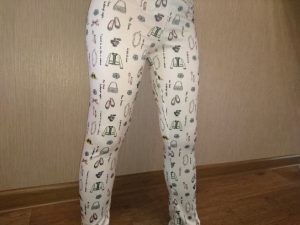
creativecommons.org
Leggings are one of the most versatile items in your wardrobe, which probably everyone has. Some people wear leggings at home or for sports training, others can even wear them to work. Looks with leggings can change dramatically depending on what exactly is worn on top. In this material we will tell you how to sew leggings for girls with your own hands. Traditionally, at the end of the article you will find a sewing master class and an exact pattern.
Tights and leggings
Leggings are tight-fitting pants that look more like very tight tights with the toes cut off. In this article we will use the words tights and leggings as synonyms, since designers themselves and stock stores often do not pay attention to the names. But, to be honest, there is still a difference.Firstly, leggings, unlike leggings, are not as tight-fitting and do not focus attention on every fold on the hips, and secondly, they are made from denser materials; denim can also be used to sew leggings.
History of leggings
The first leggings were an element of men's clothing and appeared quite a long time ago, in the Middle Ages. Back then they were made from elk skin - hence the unusual name. Later, leggings began to be cut from suede and other soft leather. But life for leggings fans didn’t get any better. This rather practical and wearable clothing had significant drawbacks. Putting on medieval leggings was extremely inconvenient: first they were wetted with water, and then they were pulled on for a long time. Very often this ceremonial part of military clothing chafed in the most sensitive places. Despite these inconveniences, leggings remained part of military uniform until the end of the 19th century. From that moment on, leggings ceased to be part of the men's wardrobe; exceptions were made only for professional dancers.
Women began to wear leggings relatively recently - the first models appeared in the 1960s, and the peak of popularity of leggings came in the 1980s. And unlike the men's version of leggings, made of poorly stretchable leather, the women's version was made of stretch fabrics. Leggings of the 1980s became bright, while previously they were mainly used in three colors (black, white and nude), then the disco of the 80s painted leggings in neon colors. Judging by the surviving photos and videos of those years, one gets the feeling that the fashion world was obsessed with two things: leggings and aerobics. Rich red, bright blue, purple, light green and sunny yellow leggings were in fashion. The most desperate ones, in addition to bright colors, also chose an unusual pattern.The image of a sporty girl who wanted to emphasize her good shape and attract attention became a model of the time. Leggings were worn to the gym, for a walk and even to the office. With them you could create both a provocative image and a rather restrained one: leggings go well with open tops, bright turtlenecks, long sweaters or pullovers, and classic jackets. Down, you can wear heavy sneakers, ballet flats or loafers. Even today, leggings are a universal solution, because they will look really strange only with wedge sandals, high-heeled shoes or flip-flops. In the 1990s, leggings became much more modest: now the color scheme of tight trousers has returned to calm basic colors. At the same time, capri leggings, a shortened version of leggings, came into fashion.
What you need to sew leggings

creativecommons.org
- A piece of elastic fabric in the color you want.
- Sewing supplies (needle, thread, pins)
- Sewing machine (this model can be sewn without it, but its presence will significantly speed up the process and improve quality)
- Printable pattern provided at the end of this article.
- Rubber
Step-by-step master class on sewing leggings
If you want to make sports leggings, choose a more stretchy fabric made from polyester or a natural fabric with a high synthetic content. This way the product will last longer and will not lose its shape.
- Iron the fabric or, better yet, steam it.
- Pin the pattern onto the fabric.
- Trace the pattern and repeat the outline, stepping back 0.5 cm from the edge.
- Fold the halves of leggings for the right and left legs in pairs with the right sides facing inward. Sew darts on each half.
- Sew the crotch seams and then the side seams.
- Press seam allowances.
- Finish the bottom edges.
- Sew in elastic and work around the top of the leggings.


 0
0





